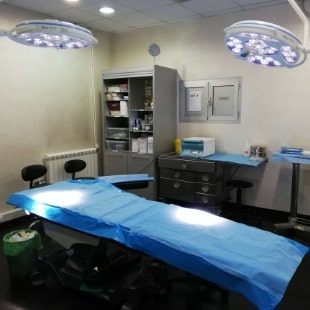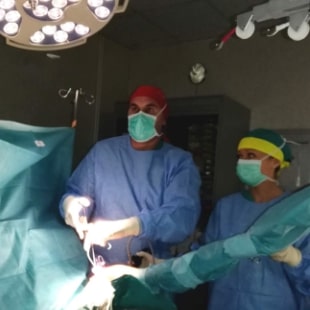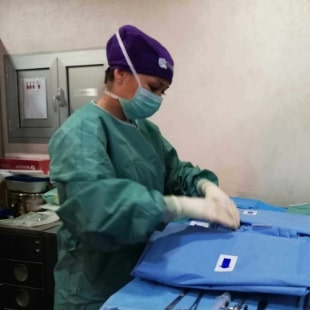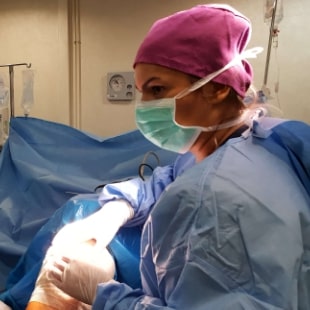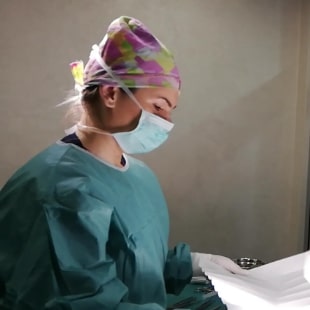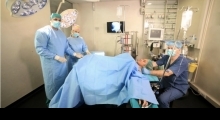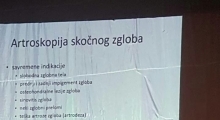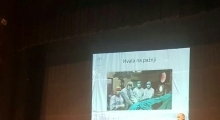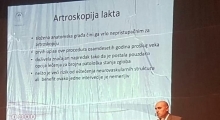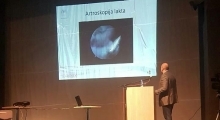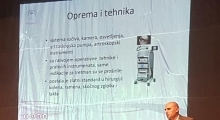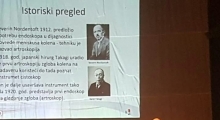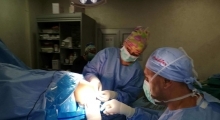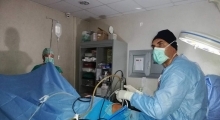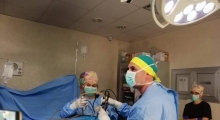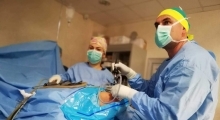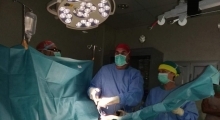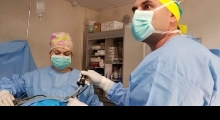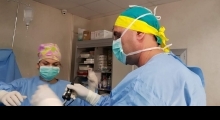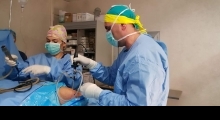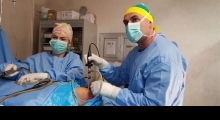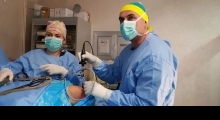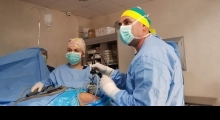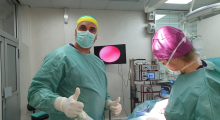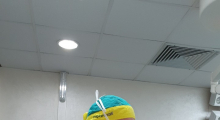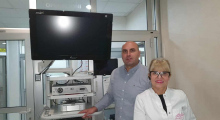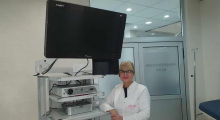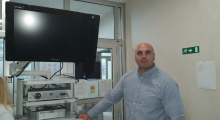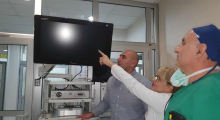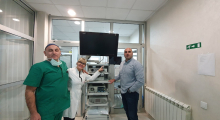Orthopedics – Arthroscopy
Center for arthroscopic surgery – special offer
The best orthopedic surgeons Dr Blagojević and Dr Glišić - knee arthroscopy (diagnostics + meniscectomy) + pre-operation preparation + the quickest recovery after only 5 times 1 hour of knee robot assisted therapy with the greatest expert for robot assisted therapy Dr Mitrović – All for €1200
Read more:
-
What is arthroscopy?
-
Which conditions can be treated with arthroscopy?
-
What is preparation for the procedure?
-
How is arthroscopy done?
-
How long is the recovery period after the procedure?
-
What are possible complications related to arthroscopy?
What is arthroscopy?
-
The inside of your joint is clearly visible
-
The joint isn’t opened – no wound stitching
-
Minimal tissue damage
-
Less pain
-
Quick recovery
-
You go home the same day
With our special robot therapists, the recovery period takes days, not months as with traditional physical therapy.
Arthroscopy is the latest surgical procedure in orthopedics. It involves making small cuts for inserting camera in the joint, as well as special surgical instruments for diagnosing and treating joint problems.
During arthroscopy, the joint is minimally open and there is significantly less chance of infection or complications in comparison to traditional large joint surgery.
Arthroscopy is the first choice (gold standard) for surgical treatments of shoulder, elbow, knee and ankle, especially with athletes and younger population
-
After arthroscopy there is usually no need for lying in hospital.
-
Arthroscopy can be done under analgosedation, spinal, regional or local anesthesia.
-
There are no cuts and no scars. Only several small incisions are made, about 5 mm each, on both sides of the joint.
-
Arthroscopy is performed by an orthopedic surgeon.
-
After the procedure, the patient can go home.
Arthroscopy is done with an arthroscope- a small tube with an optic fiber and a lens. The arthroscope is inserted into the joint through small incisions and the inside is watched on a monitor. The size of the arthroscope depends on the size of the examined joint. The arthroscope used for knee for example is 5 mm in diameter. There are very small arthroscopes, only 0.5 mm in diameter, which are used for smaller joints, like wrist.
If surgery is done along with the examination, the procedure is called arthroscopic surgery. Many procedures can be done this way. Compared to conventional surgeries, arthroscopic surgery involves much less damage to the tissue, less pain and quicker recovery.
Which conditions can be treated with arthroscopy?
Arthroscopic surgery of large joints
Knee
-
Diagnostic arthoscopy
-
Arthroscopic meniscus tear repair (suture, partial meniscectomy)
-
Lose joint fragments removal
-
Chronal defects treatment (shaving and microfracture)
-
Synovectomy
Reconstructive knee surgery
-
Anterior cruciate ligament reconstruction
-
Posterior cruciate ligament reconstruction
-
Reconstruction of medial patellofemoral ligament
Shoulder
-
Diagnostic arthroscopy
-
Lose joint fragmants removal
-
Subacromial decompression, debridement and acromioplasty
-
Arthroscopic recession of acromioclavicular joint
-
Capsular release and redressement of frozen shoulder
Reconstructive shoulder surgery
-
Arthroscopic shoulder stabilization
-
Rotator cuff reconstruction
Ankle
-
Diagnostic arthroscopy
-
Arthroscopic treatment of anterior impingement
-
Arthroscopic treatment of posterior impingement
-
Lose joint fragments removal
-
Debridement of osteochondral lesions
-
Arthroscopic treatment of Haglund’s deformity
Arthroscopy can be useful in diagnostics and treatment of non inflammatory, inflammatory and infective arthritis, as well as various joint injuries.
Non inflammatory, degenarative arthritis, ostheoarthritis, shows under arthroscope as a worn and torn cartilage. The new procedure applied with younger patients who have isolated injury on cartilage which covers the bone edges in the joint, includes „gluing“ with the patient’s own cartilage cells. The cells are harvested and grown in the lab, and after some time transplanted into the knee with the arthroscope.
In cases of inflammatory arthritis, like rheumatoid arthritis, some patients can have the inflamed tissue removed (synovectomy). This tissue that lines the joint (synovium) can be biopsed and examined under the microscope to determine the cause of the inflammation and detect infections, like tuberculosis. Arthroscopy enables getting more information than it would be possible by taking and analyzing the joint fluid.
Common knee injuries for which arthroscopy is meant, include torn cratilage (meniscus tear), ligament strains and tears, and damage to the cartilage below the knee cap. Arthroscopy is normally used for knees and shoulders, but can also be used for diagnostics and treatment of hips, wrist, ankle, foot, spine and elbow.
Bone or cartilage fragments, as well as foreign bodies like thorn or needl, that have penetrated into the joint structure, can also be removed with arthroscopy.
What is preparation for the procedure?
Arthroscopy is a procedure which is normally not connected with blood loss or complications. However, when choosing the right candidate for arthroscopy, the overall patient’s health must be taken into consideration. The patient shouldn’t have any problems with heart, lungs, kidneys or liver. If there is a heart condition or an emphysema, the patient’s state should be optimized prior to the operation. Patients who take anticoagulants should adjust their therapy to the operation. Other health issues like diabetes or high blood pressure should also be put under control first.
Pre-operation examination includes physical examination, blood and urine lab tests, ECG and lung X-rays. Every sign of possible infection postpones the operation, unless the infection is of the joint.
How is arthroscopy done?
Arthroscopy is usually done with no need of patient staying at the hospital. The type of anesthesia depends on the joint which is to be examined and the overall health condition of the patient. The procedure can be done under total, spinal or epidural anesthesia, regional blockage or even local anesthesia. On the side of the joint a small incision is made for introducing the arthroscope. If other instruments are needed, additional cuts are made. Through these small cuts, the surgeon inserts surgical tools for cutting, removing or suturing damaged structures. After the procedure, the arthroscope is pulled out, cuts are sutured and bandaged.
How long is the recovery period after the procedure?
Immediately after the operation, the patient feels sleepy because of the anesthesia. If needed, pain medication is applied. If the procedure is performed under local anesthesia, it can be completely painless. With epidural and regional anesthesia, numbness and weakness are normal, but stop before the patient leaves the hospital.
Incisions made for this procedure are small. Usually one or more cuts are made, 5 mm in diameter, on both sides of the joint. After the procedure, these cuts are bandaged. The dressing may absorb some of the drained wound liquid, but shouldn’t be taken off until the doctor approves. For the first few days after the surgery, the dressing should be kept dry. The patient must at once inform the doctor about any unusual pain within the joint, swelling, redness or warmth sensation, as well as any injury to that joint.
Patients are advised to rest for the first few days after the surgery, with the joint in an elevated position. Ice packs should be put on the joint to lessen any pain or swelling. After the procedure, certain exercises are gradually introduced to strengthen muscles around the joint and prevent contractures of the surrounding soft tissue. The goal is slowly and safely achieving again the strength and stability of the joint, returning the scope of movements, and preventing growth of scar tissue. This is an essential part of the recovery program, for the optimal results of the procedure.
Development of quality fiber-optic equipment enabled the development of miniature arthroscopy. Today, it is possible to perform arthroscopy on small joints. Arthroscopy has become a very important means in arthroscopic surgery, and is becoming more and more irreplaceable with the improvement of arthroscopic instruments.
What are possible complications related to arthroscopy?
Possible complications are very rare and include bleeding inside the joint, joint infection and side effects of anesthesia.
Video gallery
New: knee arthroscopy with rehabilitation on robot – in only 5 days as if you have never had an operation
Knee arthroscopy and physical rehabilitation on our CPM robot
Arthroscopy in Analife hospital
Arthroscopy, PRP treatment and physical rehabilitation on CPM knee robot
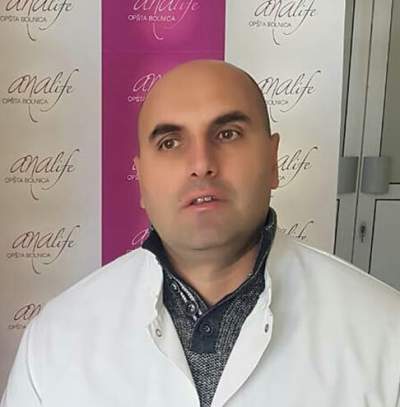
Ass. dr sci.med Miodrag Glišić - Orthopedics and traumatology
Field of expertise: arthroscopy of large joints
Gallery
Monday-Friday from 09-20h
Saturday from 09-15h
Opšta Bolnica Analife
Skadarska 5
(Zemun), Beograd



.png)
